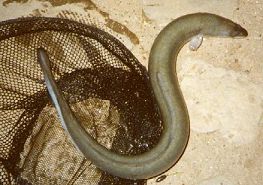Eels evoke strong emotions in many people. For some anglers, this serpent-like fish is a bait-snaffling menace which tangles tackle; others are fascinated by eels and defend them with a passion unsurpassed by any other single-species interest group. And scientists have still been unable to unravel all the mysteries of eels’ remarkable life history.

Born at sea
There is only one species of eel found in British fresh waters, the European eel. It begins life in the Sargasso Sea, in the tropical, western Atlantic, and the transparent, flattened larvae are carried to European coasts by the Gulf Stream currents – a journey which takes a year. They then change shape and darken to become elvers, which either grow to maturity in brackish water or ascend rivers and thence enter still waters.
All adult eels share common features – a long, narrow dorsal fin which merges with the anal fin and tail; the pair of pectoral but no pelvic fins; the very small gill openings; and a body covered in a layer of minute scales beneath the outer skin. However, some eels retain the pointed shape of their mouths whereas others – for unknown reasons – develop mouths which are broad and frog-like. Eels have catholic diets, feeding on insect larvae, snails, fish eggs, small fish, frogs etc. Eels are largely nocturnal and their sense of smell is extremely well developed, although they can tolerate water pollution.
Pointy or broad
For most of their lives, eels have dark-coloured backs and lighter, often yellowy undersides (hence the description ‘yellow eels’). Female eels grow larger than males and tend to dominate freshwater populations. Growth is temperature dependant, but yellow eels usually stay inland for between six and 15 years. If they become trapped in stillwaters from which they cannot escape, however, they may live for 30 years or more.
Before they migrate back to sea, the adults change colour and become so-called ‘silver eels’. Their jaws and intestines shrink, and they cease feeding, by when their bodies may contain 30 per cent fat. Migration downriver takes place on dark nights, often in flood conditions. It is thought that eels’ spawn and milt develop on the return journey to the Sargasso Sea, although it is unclear how they navigate and, as yet, no-one has seen an eel spawning!
Unhooking and Handling of Eels
It has been brought to the attention of the Specialist Eel Angling Groups that there has been advice on the handling of eels placed within the angling press in recent weeks. The advice that has been given does not fall within the recommendations of eel handling as published within the S.A.A ( Specialist Anglers Alliance) code of conduct.
The Specialist Eel Angling Groups feels it is their place to advise on the correct procedure of hook removal and holding of captured eels. We strongly advise that ALL anglers refer and adopt the guidelines on eel handling as printed within the S.A.A code of conduct. We would also like to advise your readers of the correct procedure within this press release.
We advise that all potential eel bites/ takes should be struck as early as possible so as to reduce the potential of deep hooking. Once an eel has been hooked and landed we advise the eel be moved away from the waters edge and laid on soft material such as a Carp un-hooking mat. If the eel is found initially to be "uncontrollable" , we recommend lying the eel on its back for a short period of 20 to 30 seconds . The eel and the captors hands should be kept moist at all times, to prevent the removal of the protective layer of slime which the eel needs to keep itself free from infections. It was advised in one angling magazine that the captor should "Wrap the eel in newspaper", so as to give the captor a "better grip" of the eel, We cannot express our feelings strongly enough on the potential damage that can be caused to a eel in these circumstances.
Once the eel has been "calmed down" by gentle handling, the captor should assess the location of the hook, If the hook is visible in the front of the mouth, strong forceps should be used to remove the hook. If the hook is "out of sight" we strongly advise against the use of a disgorger, as these have the potential to puncture vital organs eg heart, liver ,etc, that are located just behind the eels head. We advise, instead that if the hook is NOT Visible that the captor DOES NOT attempt removal, Instead the line should be cut as close to the eels mouth as possible and the hook left in its position, ( captures of eels by our members have shown that some eels with the hook out of sight and the line cut close as possible to the mouth have later regurgitated the bait with the hook within it or passed the hook through its digestive system).
When the captor is holding the eel for pictures or release we strongly advise that the eel is NOT to be gripped tightly within about a 10 inch area of the head, as this can also damage the internal organs of the eel and in no circumstances should your readers insert a finger into the gill opening of an eel, this is destined to result in the death of the said eel. A picture of an 8lb+ eel in the press recently showed the captor lifting the eel in this manner, to the disgust of many eel anglers, this showing a complete lack of respect to this amazing fish.
–*–
If you are interested in cheap eel fishing tackle and bait, please click here.








